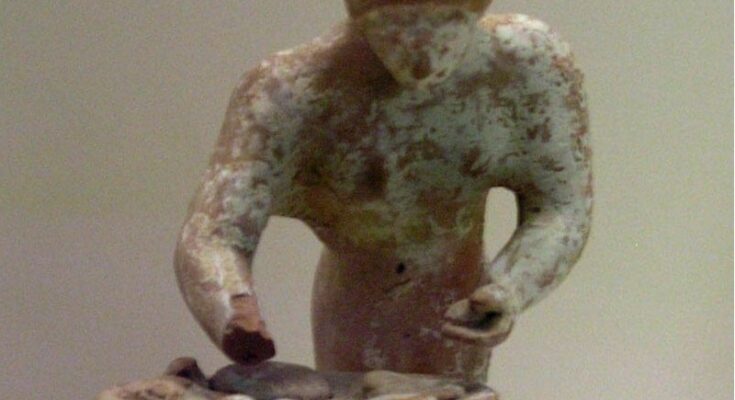Modern chefs have been recreating bread from ancient Greece that has been intricately woven into human history for thousands of years.
Bread, one of the oldest foods, started being prepared in ancient Egypt. This coincided with the rise of civilization. Egypt, with its abundant wheat fields, played a pivotal role in this.
Herodotus noted that, in ancient Egypt, bread was kneaded with the feet, a practice that persisted into the early 20th century in many regions of Greece and Europe.
Greek sailors and traders brought Egyptian flour to Greece, where the creation and baking of bread became an art form.
The bread held symbolic and ritualistic significance. It was often associated with religious ceremonies and considered a divine gift. Ancient texts reveal the Greeks offered bread to the gods, calling them “divine loaves.”
The profound connection to wheat and bread is underscored by the Greeks’ reverence for the goddess Demeter. During the Thesmophoria festival in Eleusis, large loaves were offered at her temple.
The craft of making bread was mastered in ancient Greece
Ancient Greek bakers mastered the craft, using simple ingredients such as wheat, barley, flour, water, salt, and, at times, olive oil or honey. Skilled bakers were highly respected in society, and breadmaking techniques evolved over time, influenced by other civilizations.
The ancient Greeks became so skilled at breadmaking that, by 400 B.C., they had come up with around 72 different types of bread. Competitions were held to see which bakery could produce the best bread, with Athens becoming well-known for its loaves. Athens boasted about Theario, its finest baker, whose name appeared in the writings of many authors.
Lynceus of Samos, a classical author of comedies who lived in the 3rd or 4th century BC, said in a letter that: “The Athenians talk a great deal about their bread, which can be got in the market, but the Rhodians put loaves on the table which are not inferior to all of them.”
The bread was made of flour ground in household mills and baked at home. The first bakeries appeared much later around the 2nd century B.C. during Roman rule.
Among the various types of bread, there were zymitis (leavened), azymos (unleavened), and simigdalitis (made of fine flour from quality wheat).
Hippocrates mentioned various bread types made from wheat flour, sifted or not, with or without leaven, with bran, semolina, honey and cheese, oil, poppy seeds, or sesame seeds. The rarity of wheat and its high nutritional value meant that wheat bread was consumed primarily by high-status individuals, while the common people consumed barley bread.
Athenaeus, a 2nd to 3rd century AD grammatist, names a long list of various breads in The Deipnosophistae (dinner table philosophers), sometimes called the oldest surviving cookbook, that underlines the importance of bread in ancient Greek life.
The artolaganon: the famous bread of ancient Greece
The artolaganon was one of these breads. The recipe of the artolaganon comes from a book about baking, unfortunately not survived, written by Chrysippus of Tyana.
Artolaganon means laganon bread (artos is bread in Greek). Laganon appears frequently in both Greek and Roman sources. Hesychius, a Greek grammarian who lived in the 5th century, describes it as a circular sheet of dough made of water and white wheat flour, dried and fried in olive oil. Athenaeus confirms the shape of the laganon, adding that it is thin.
Modern cooks have been recreating this ancient Greek bread. For example, the blog Historical Italian Cooking demonstrated its preparation and baking in the following video:
Pliny the Elder (1st century CE) also mentions artolaganon, “bread cake,” which is prepared with milk, pepper, wine, and lard or oil. There is no mention of the leavening agent, yeast, or sourdough.
Today, the ancient art of breadmaking lives on in Greece. Traditional bakeries throughout the country proudly preserve centuries-old recipes and techniques. Greek bread, known for its rustic crust and soft interior, remains a beloved staple in Greek cuisine.
The legacy of breadmaking in Greece showcases culinary ingenuity and reflects the cultural significance and mythological ties that have shaped Greek society for millennia.
Related: Archaeologists Discover 8,600-Year-Old Bread in Turkey



